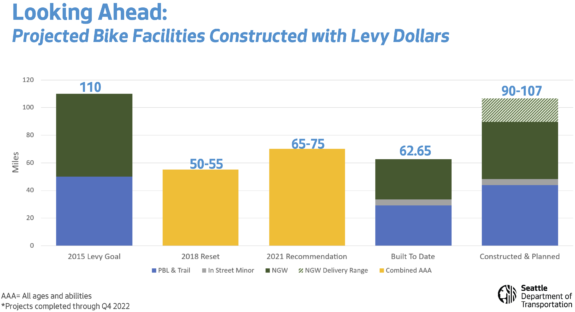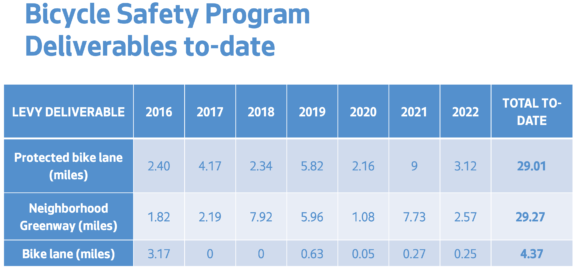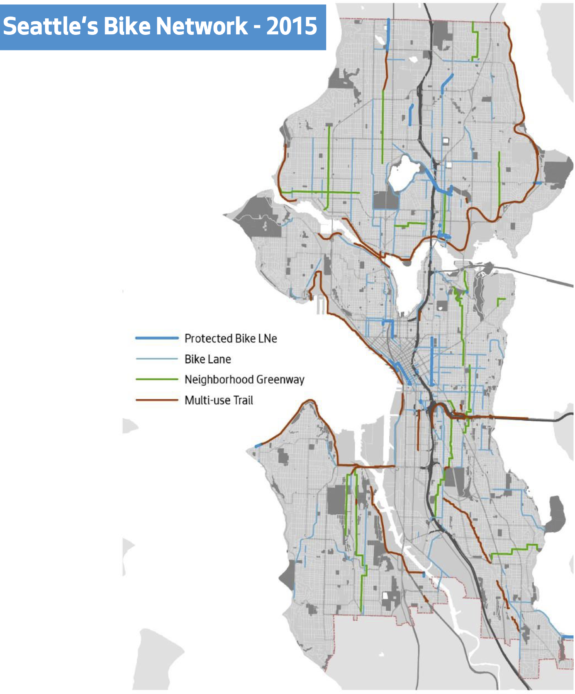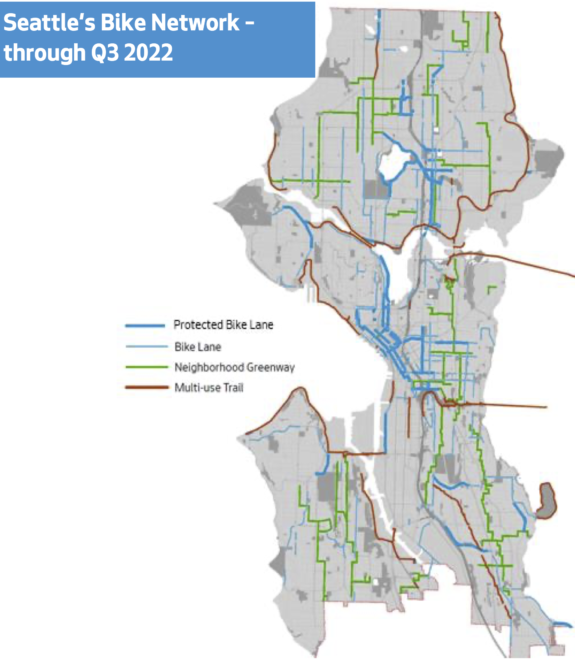
Seattle voters overwhelmingly approved a taxing levy in 2015 with the stated goal of building 110 miles of new or upgraded protected bike lanes and neighborhood greenways across the city by the end of 2024. As of the start of 2023, the city has only constructed 57% of that goal, according to a presentation SDOT is set to give the Move Seattle Levy Oversight Committee tomorrow (February 7).
But we already knew the city was behind on delivering its bike promises. We’ve unfortunately been tracking this problem since the very first year of the levy. After leading the development and passage of the levy, Mayor Ed Murray dropped the ball badly in 2016 and into 2017 before resigning in disgrace amid accusations of sexual abuse. At the time, SDOT placed blame for the bike project delays on “various reasons” and told Seattle Bike Blog that they had a plan to make sure bike route delivery stayed on schedule in the coming years:
“We recognize projects get delayed for various reasons and to that end, are planning and designing additional 2017 and 2018 projects to prepare for schedule risks,” said [SDOT Spokesperson Norm] Mah. “By planning and designing more mileage then we can accommodate delays in some projects and move enough corridors forward to make up for delays in others.”
— Advertisement —
 In order to deliver on Move Seattle, SDOT would need to build an average of 12 miles of protected bike lanes and neighborhood greenways every year. But after a slow start, that number ticked up to about 13 miles per year in 2017, then 14 miles per year in 2018. Seattle would need strong leadership to get the voter-mandated bike routes back on track, but instead Jenny Durkan became mayor. By the end of her first full year in office she still had not hired an SDOT Director, and Seattle had successfully constructed just 4% of its 2018 bike lane goal. The miles needed per year to meet the Move Seattle goal ticked up to 15.5, but Durkan had made it clear by this point that she was not interested in pursuing the levy’s bike route goals, and the Levy Oversight Committee sounded the alarm about the “disproportionately large” cuts to the bike plan. Hundreds of people protested the bike cuts during a June 2019 City Hall rally and bike ride downtown.
In order to deliver on Move Seattle, SDOT would need to build an average of 12 miles of protected bike lanes and neighborhood greenways every year. But after a slow start, that number ticked up to about 13 miles per year in 2017, then 14 miles per year in 2018. Seattle would need strong leadership to get the voter-mandated bike routes back on track, but instead Jenny Durkan became mayor. By the end of her first full year in office she still had not hired an SDOT Director, and Seattle had successfully constructed just 4% of its 2018 bike lane goal. The miles needed per year to meet the Move Seattle goal ticked up to 15.5, but Durkan had made it clear by this point that she was not interested in pursuing the levy’s bike route goals, and the Levy Oversight Committee sounded the alarm about the “disproportionately large” cuts to the bike plan. Hundreds of people protested the bike cuts during a June 2019 City Hall rally and bike ride downtown.
By the time the COVID-19 pandemic hit, the voters’ bike route plan already seemed unlikely. Understandably, the city’s delivery of bike infrastructure took a hard hit in 2020. Going into 2021, the city would need to build 18.5 miles per year to meet the levy’s goal.
But this is where things got really interesting. 2021 was SDOT Director Sam Zimbabwe’s first year to actually run the department without being in total crisis response mode, and SDOT delivered 16.73 miles of bike routes, 9 of which were difficult-to-build protected bike lanes. That was within spitting distance of the mileage the department would need to deliver every year to meet the levy’s goal. The turnaround was astounding, and it showed what the department is capable of when given the proper guidance and resources. It also completed some notoriously difficult and important connections, especially in and around downtown.

 SDOT did not maintain the 2021 pace during Mayor Bruce Harrell’s first year in office, another year with no SDOT Director for the first nine months. But with Gregg Spotts now running the department, he and Mayor Harrell are saying all the right things and they seem to be preparing a last-minute dash to build out the voters’ bike routes before the levy expires at the end of 2024. As of the start of 2023, the department needs to build a shade under 26 miles of protected bike lanes and neighborhood greenways in each of the next two years to meet the original goal. SDOT’s presentation shows that they are currently planning about 15.25 miles of protected bike lanes, 15–18 miles of neighborhood greenways and up to 12.5 miles of new or upgraded Healthy Streets. That’s a total of 36.25 miles of new bike routes plus upgrades to some existing routes.
SDOT did not maintain the 2021 pace during Mayor Bruce Harrell’s first year in office, another year with no SDOT Director for the first nine months. But with Gregg Spotts now running the department, he and Mayor Harrell are saying all the right things and they seem to be preparing a last-minute dash to build out the voters’ bike routes before the levy expires at the end of 2024. As of the start of 2023, the department needs to build a shade under 26 miles of protected bike lanes and neighborhood greenways in each of the next two years to meet the original goal. SDOT’s presentation shows that they are currently planning about 15.25 miles of protected bike lanes, 15–18 miles of neighborhood greenways and up to 12.5 miles of new or upgraded Healthy Streets. That’s a total of 36.25 miles of new bike routes plus upgrades to some existing routes.
It is unlikely SDOT will meet the full 110-mile goal from the Move Seattle Levy. But when the dust settles on city streets in 2025, they may have gotten close. They are currently anticipating between 90 and 107 miles, largely dependent on delivery of neighborhood greenways. (The exact accounting is fuzzy since funding can come from many different places in addition to the levy, but the point is that they are trying to get the mileage up). Given the pandemic and some bike lane miles costing more than anticipated, getting close would be a significant achievement. The numbers are so close that I wonder if there is a good, long and cheap project they could add that would allow them to actually meet the full mileage goal (1st Avenue S? Airport Way? Lake Washington Boulevard? Beach Drive SW?). Maybe I’m getting greedy…
Of course, there are a lot of “ifs” involved here. Building bike lanes is difficult work, and it will take some serious political commitment to follow through on bike route improvements at this scale. Exercise your online survey muscles to make sure they are ready for a lot of community engagement. If our city manages to pull this off, it will be the biggest expansion of protected bike routes in Seattle history. Let’s do it.








Comments
6 responses to “Thanks to years of delays, Seattle has 2 years to build 47 miles of voter-approved bike routes”
SDOT is like a kid who forgot he had homework due on Monday and is pulling an all-nighter on Sunday. Hopefully they can actually complete the assignment. I’m not holding my breathe though, especially if people try and block new lanes like the Missing Link.
1st Ave S. makes a lot of sense for a long protected bike lane as SDOT recently made a temporary one and there’s no bike lanes in SoDo at all. But that project might be saved for the Safe Streets Funding Cantwell just got for the city.
The Seattle Transit plan is an attempt to reset the four modal plans; SDOT now may recognized that scarce right of way is a key constraint. The Kubly SDOT vastly over promised on many margins, not just bike lanes; the Kubly SDOT RapidRide plans had to be reset; there are still no sidewalks on the north part of Aurora Avenue North. But another factor is the change in approach; the earlier target miles of bike lane were only with paint stripes; now, some are much more costly PBL.
Will levy funds be used to build bike infrastructure on Lake Washington Blvd, or is this out of scope (it was at least partially funded by council)? Is this project happening in 2023 or 2024? https://www.seattlebikeblog.com/2022/09/27/morales-proposes-funding-for-a-walking-and-biking-path-on-lake-washington-blvd/
It’s disappointing that greenways are seemingly being lumped in with protected bike lanes when evaluating whether the city is meeting (or close to meeting) the levy goals. At a casual glance, putting greenways on a map can make it seem like there’s more real bike infrastructure than there really is.
From what I’ve seen and experienced as a SE Seattle resident, the Rainier Valley North South Greenway is better than nothing as far as bike infrastructure goes, but that’s not a very high bar or something we should be aiming for. The route runs in the street with no physical separation so it’s not protected. Your safety on the greenway depends entirely on the good will and attention span of the drivers driving around the haphazardly placed signs. Drivers drive around and/or flatten the temporary signs, many of which are covered in graffiti or are continually moved by people angry about changes to the car-first-everything-else-last status quo. No permanent physical barriers or chicanes were ever built to discourage cut-through drivers. The greenway has served to lessen traffic somewhat and reduce speeds somewhat, but it’s out of the way and inefficient for bicyclists trying to get from Rainier Beach to points north; I mean, just look at that over-caffeinated squiggly green line that darts left and right for every block north or south. It also includes a very steep and very much NOT all-ages segment through Columbia City, sharing the main traffic lane with distracted drivers trying to find parking. So basically, as a through route, it’s inefficient and unsafe and I would struggle to characterize any portion of it as all-ages due to the lack of physical separation with cars.
Looking at the map above titled, “Seattle’s Bike Network through Q3 2022”, all I see in all of SE Seattle for a connected north south route is the greenway. Take that unprotected route away, and what are you left with? Not much, and definitely nothing safe and connected.
As far as unconnected north/south protected bike routes in SE Seattle — Is there any plan to build on the excellent but short and lonely Wilson Ave protected bike lane that runs north from Seward Park Ave S. and ends one block south of the Seward Park business district (Third Place Books, Chuck’s, etc.) at S. Dawson St? I’m glad the lane is there, but at the moment, it’s like a beautiful bridge to nowhere. It doesn’t even serve to get neighbors safely all the way to the bookstore, since the separation / protection peters out one block south of that with no warning or direction to users. The bike lane through the business district and north to Genesee is one big scary paint-only door zone adventure. Any plans to protect this bike lane and better connect it to the greenway where they intersect on Genesee?
To address the unconnected problem — how about linking Seward Park to Hillman City and Beacon Hill with a protected bike lane on Orcas over to the lane on Wilson? How about linking the Seward Park neighborhood with Dunlap and Rainier Beach by extending the bike lane south at least one direction on Seward Park Ave from Wilson & Seward Park Ave S. to S. Grattan St (this would require removing on street parking south of Othello, something SDOT did once then reneged on, possibly due to complaints about loss of street parking from the private Kline Galland convalescent home)? This would also connect to the S. Kenyon St. “safe route to school”, a descriptor so undeserved for the Rainier Ave-to-Seward Park Ave S segment that it demands mockery and opprobrium. Safer than having your child ride or walk on I-5, maybe.
How about connecting the woefully underused protected bike lane on Othello / Myrtle / Swift with something, anything? Provide a safe connection with the Othello light rail. Run it east to Seward Park Ave. Run it west to Georgetown and South Park. Run it north to 15th Ave.
These are all things that the city needs to hear when developing the Seattle Transportation Plan. I have more coming on that (posts focusing on different parts of town), so stay tuned. I’ll try to look into the routes you mention when I get to the SE section.
But to answer your question about including neighborhood greenways, yeah, I agree with your points. Many of the city’s greenways have proven to be a big disappointment, and you hit the two biggest issues on the head. 1) Not enough traffic diversion to reduce cut-through traffic and keep traffic volumes as low as possible and 2) Shoehorning complicated and hilly greenways into places where bike lanes would be much more effective. Rainier Valley is the best example, though West Seattle has some, too. However, the Move Seattle Levy specifically called for these greenways, so that’s why they are relevant in this post. We should write the next levy and transportation plan differently to clarify when a greenway is and is not appropriate and to clarify the design standards greenways must meet.
Thanks for your kind and succinct reply to my wall of text, Tom. Being a cyclist and living in the south end for almost 20 years has my frustration starting to bleed out, I think! Thank you for your vital coverage of cyclist and pedestrian safety issues throughout Seattle.
I will give huge kudos to Councilmember Morales for being the only politician in recent memory to give a rat’s behind about street safety in District 2. I’m thrilled that she’s running for re-election. I hope she wins her race and will continue to support and fund improvements in this long neglected part of the city.
This some good reporting Tom, real news of consequence to everyone who rides in Seattle.